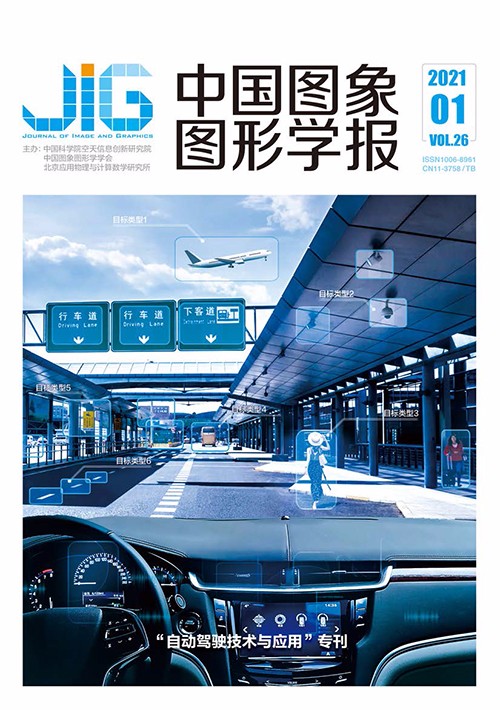
利用边缘计算的多车协同激光雷达SLAM
摘 要
目的 激光雷达实时定位与建图(simultaneous localization and mapping,SLAM)是智能机器人领域的重要组成部分,通过对周边环境的3维建模,可以实现无人驾驶车辆的自主定位和精准导航。针对目前单个车辆激光雷达建图周期长、算力需求大的现状,提出了基于边缘计算的多车协同建图方法,能够有效地负载均衡,在保证单个车辆精准定位的同时,增加多个车辆之间的地图重用性。方法 构建基于阈值的卸载函数,论证边缘计算下的多车卸载决策属于势博弈问题,设计实现基于边缘计算的势博弈卸载算法,在模型具有纳什均衡的基础上实现任务调度,引入α-Nash最佳响应动态加速算法收敛,并采用由粗到细的点云匹配方法提高地图匹配性能,实现车辆的精准定位。最后,基于地图的相对可信度,高效地合并基站覆盖范围内的多个车辆的建图数据。结果 实验表明,基于博弈论的调度方法在保证定位可靠性的前提下,能够有效地实现多车协同SLAM,且多车协同的定位与建图结果与使用载波相位差分技术(real-time kinematic,RTK)的高精度差分全球定位系统(differential global positioning system,DGPS)结果足够接近,相比于单车建图而言,横向定位和纵向定位的平均精度分别提高了6.0倍和3.9倍。结论 本文方法解决了基于边缘计算的多车协同激光雷达SLAM问题,借助边缘服务器的计算资源,无人驾驶车辆可以有效地减少本地资源需求和定位延迟。该方法通过各个车辆之间的资源博弈,最终实现纳什均衡。实现基于边缘计算的激光雷达定位服务,且高效地完成多车之间的地图合并,仿真和真实环境中的实验表明了方法的有效性。
关键词
Cooperative LiDAR SLAM for multi-vehicles based on edge computing
Cui Mingyue1, Zhong Shipeng1, Liu Siyao2, Li Boyang1, Wu Chenghao2, Huang Kai1(1.School of Data and Computer Science, Sun Yat-sen University, Guangzhou 510000, China;2.School of Intelligent Systems Engineering, Sun Yat-sen University, Shenzhen 518000, China) Abstract
Objective LiDAR simultaneous localization and mapping (SLAM) is an important component of the field of intelligent robotics. The robot should be able to perceive the information of the surrounding environment and accurately locate its own position, which is also the premise for the robot to autonomously navigate. Building the entire map requires the single vehicle to drive all over the whole area, which makes the mapping periods longer. In addition, more data require more computing power for onboard units. To solve the above problems, a cooperative LiDAR SLAM for multi-vehicles based on edge computing method is proposed. This method can make the load balance by offloading tasks to the edge server. Aside from ensuring accurate localization of the single vehicle, it can also increase the reusability of the mapping results for multi-vehicles. This study models the computation offloading decision-making problem among multi-vehicles as a task offloading game. It designs the offloading algorithm based on the potential game to compute the task scheduling sequence. The concept of relative confidence is introduced to reduce the odometer error in the process of mapping as much as possible, which also makes our merged maps of multi-vehicles more accurate. Method First, this study constructs a threshold-based offloading function that includes latency constraint and signal quality constraint. Then, this study proves that the minimum latency problem of multi-vehicles is a potential game. The potential game always reaches the Nash equilibrium and has limited improved properties. Therefore, the relevant strategy based on the potential game is designed for offloading tasks. With the characteristics of the Nash equilibrium, our algorithm ensures that vehicles in equilibrium can obtain mutually satisfactory solutions. This study introduces the concept of α-Nash dynamics to speed up the convergence of the algorithm. Then, a coarse-to-fine point cloud matching scheme is used to realize the map matching. During the coarse matching phase, the point cloud data of different vehicles are initially matched. This study uses the fast point feature histogram algorithm to extract key points and descriptors from the point cloud and the distance between the point pair within the spherical neighborhood of the key point. Then, the random sample consensus(RANSAC) method is used to estimate the point-to-point correspondences between the key points, which can obtain the initial matrix rotation and translation matrix that describes the rough relative transformation of two maps. In the fine matching phase, the iterative closest-point algorithm is used to further optimize the matching results and increase accuracy. On the basis of this method, matching two-frame point clouds can converge faster and achieve a better matching result. Finally, local LiDAR maps are merged based on relative confidence. The node with the lowest weight is selected, then the node set connected with the node is sorted according to the relative confidence and the size of the overlapping area. Finally, the map is merged according to the sorted order, and the above steps are repeated until all nodes are traversed. Result To verify the effectiveness of this study, we conducted simulation and real-world experiments. In the simulation experiment, α is set to different values, and experiments are conducted with different numbers of vehicles. This study takes the average number of time slots and the average system-wide overhead as two important performance metrics, which indicate the convergence speed of the algorithm and the efficiency of reducing system overhead, respectively. Results show that as α decreases, the convergence speed increases, while the efficiency of reducing the system overhead decreases. To balance the two performance metrics mentioned above, the system sets the parameter α to 0.8. Results also show that under the same parameter, the average number of time slots and the average system-wide overhead increase almost linearly as the number of vehicles increases. This finding shows that our algorithm adapts well with different sizes of users. In the real-world scene, a 1.49 km campus road is chosen as the test section, including turning, going straight, and changing lanes. Three base stations and four autonomous vehicles with identical hardware configurations are deployed in the test environment. The test area is divided into three parts with the base station as the center because of the limitation of the actual number of vehicles. Three to four vehicles are presented in each area to simulate the effect of mapping results for nine vehicles. The experiment result shows that the trajectory of the cooperative mapping are closely matched with that of real-time kinematic, while the deviation for single-vehicle mapping is much larger. In addition, compared with single-vehicle mapping, the average accuracy of latitude and longitude localization for cooperative mapping is improved about 6.0 and 3.9 times, respectively. In the worst case, the accuracy improves about 1.7 times in latitude and 1.6 times in longitude. Conclusion This paper proposes an approach to offloading SLAM tasks based on edge computing in the multi-vehicle scenario. On the basis of edge computing, autonomous vehicles can effectively reduce local computing power and the latency of localization. This method achieves Nash equilibrium by means of resource games among several vehicles. While each vehicle realizes its accurate localization, it collaborates with other vehicles to complete the overall map construction. Simulation and experimental deployment in the real environment demonstrate the effectiveness of our method. We believe that the cooperative LiDAR SLAM for multi-vehicles based on edge computing can effectively increase the quality of service for autonomous driving.
Keywords
edge computing simultaneous localization and mapping(SLAM) task offloading multi-vehicle collaboration autonomous driving
|



 中国图象图形学报 │ 京ICP备05080539号-4 │ 本系统由
中国图象图形学报 │ 京ICP备05080539号-4 │ 本系统由